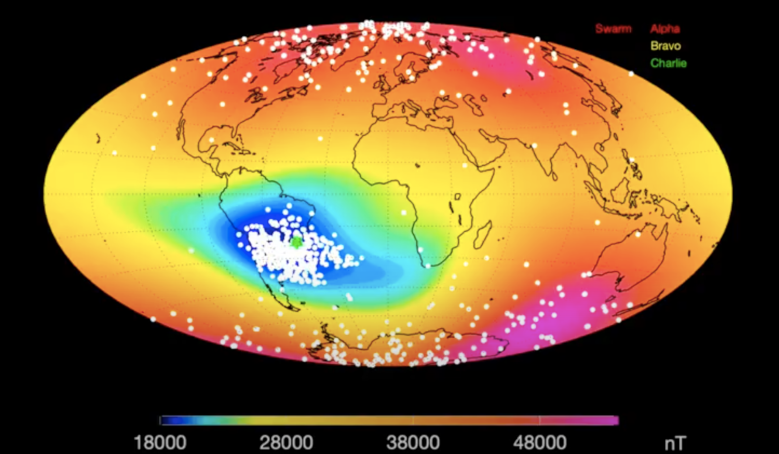Earth’s magnetic field, produced by swirling convective currents of molten iron 300 kilometres beneath our feet, is weakening at a certain spot say scientists at NASA, a small, but growing problem that could disrupt satellites and spacecraft say the space agency.
Earth’s magnetic field is vital to life on our planet. The electrical currents generated by slowly moving liquid iron in the outer core provides a protective shield for the planet. If we didn’t have one, an incessant stream of cosmic radiation and charged particles from the Sun would rain down on the surface constantly exposing humans and other lifeforms to harmful radiation.
Over the last 200 years, the magnetic field has lost around 9 percent of its strength on a global average, however in the last few years scientists noticed that between Africa and South America, a large region of reduced magnetic intensity has developed.
This is known as the South Atlantic Anomaly (SAA) and other space agencies including ESA have also been keeping an eye on it.
Currently, the SAA creates no visible impacts on daily life on the surface, however last year, using data from their Swarm telescopes, ESA reported that the anomaly was causing technical disturbances in satellites orbiting Earth.
Worringly, the anomaly is growing and is now seen to be moving westward at a pace of around 20 kilometres per year.
It is also splitting - recent data shows the anomaly's valley, or region of minimum field strength, has split into two lobes, creating additional challenges for satellite missions.
Earth’s magnetic field is often visualised as a powerful bar magnet at the centre of the planet, with north and south poles that represent opposing magnetic polarities and invisible magnetic field lines encircling the planet between them.
But the core magnetic field is not perfectly aligned through the globe as it tilts at around 11° to the axis of rotation. This, and the flow of molten metals within the Earth’s outer core is what creates the SAA.
It has been speculated whether the current weakening of the field is a sign that Earth is due for the north and south magnetic poles to switch places. Studies have shown that the magnetic pole is shifting location and rather swiftly.
Pole reversal events have occurred many times throughout the planet’s history. Over the last 20 million years, it has been happening about every 200,000 to 300,000 years and it has been more than twice that long since the last reversal. The jury is not out though and some scientists think that it might be down to how the Van Allen Belts trap radiation instead.
Around Earth, Van Allen belts trap high energy particles emitted from the Sun in two giant donut-shaped zones, with the innermost one beginning about 644 kilometres (400 miles) above the planet’s surface.
Trapped on magnetic field lines, the particles bounce back and forth from pole to pole. But sometimes, if a particularly strong outburst of solar radiation hits Earth, the belts can become more energised than usual causing the magnetic field to be deformed and allowing the charged particles to dip into the atmosphere where low-Earth orbit satellites reside.
"The observed SAA can be also interpreted as a consequence of weakening dominance of the dipole field in the region," said Weijia Kuang, a geophysicist and mathematician in Goddard's Geodesy and Geophysics Laboratory. "More specifically, a localised field with reversed polarity grows strongly in the SAA region, thus making the field intensity very weak, weaker than that of the surrounding regions."
The true nature behind this slowly evolving "dent" in the magnetic field has not been fully established and the challenge now is to understand the processes in Earth’s core driving these changes.
Along with Swarm data, scientists are also using geodynamo models to understand how the SAA is changing and to prepare for future threats to satellites and instruments.
"This is similar to how weather forecasts are produced, but we are working with much longer time scales," explained Andrew Tangborn, a mathematician in Goddard's Planetary Geodynamics Laboratory.
"Even though the SAA is slow-moving, it is going through some change in morphology,” says Terry Sabaka, a geophysicist at NASA's Goddard Space Flight Center in Greenbelt, Maryland. “So it's also important that we keep observing it,” he added.











